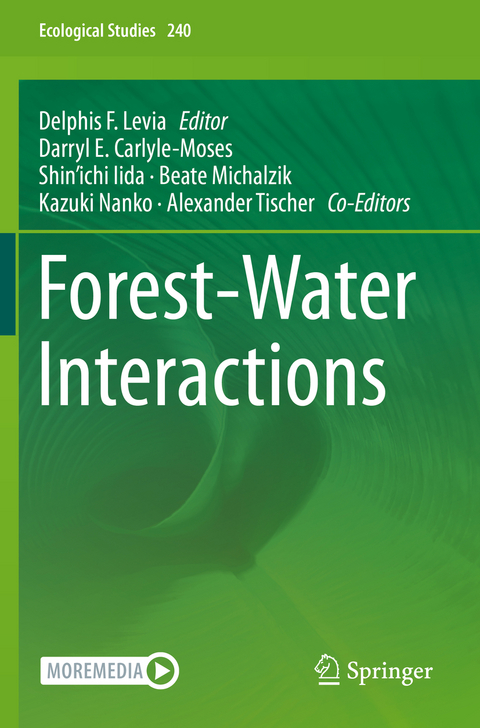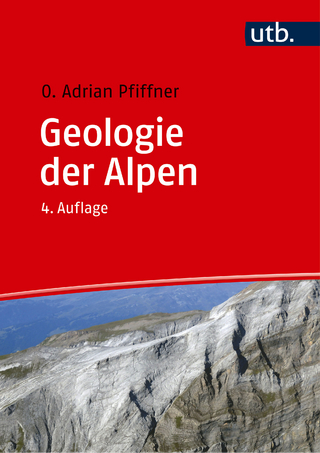
Forest-Water Interactions
Springer International Publishing (Verlag)
978-3-030-26088-0 (ISBN)
The United Nations has declared 2018-2028 as the International Decade for Action on Water for Sustainable Development. This is a timely designation. In an increasingly thirsty world, the subject of forest-water interactions is of critical importance to the achievement of sustainability goals. The central underlying tenet of this book is that the hydrologic community can conduct better science and make a more meaningful impact to the world's water crisis if scientists are: (1) better equipped to utilize new methods and harness big data from either or both high-frequency sensors and long-term research watersheds; and (2) aware of new developments in our process-based understanding of the hydrological cycle in both natural and urban settings. Accordingly, this forward-looking book delves into forest-water interactions from multiple methodological, statistical, and process-based perspectives (with some chapters featuring data sets and open-source R code), concluding with a chapter on future forest hydrology under global change. Thus, this book describes the opportunities of convergence in high-frequency sensing, big data, and open source software to catalyze more comprehensive understanding of forest-water interactions. The book will be of interest to researchers, graduate students, and advanced undergraduates in an array of disciplines, including hydrology, forestry, ecology, botany, and environmental engineering.
lt;p>Delphis Levia
Prof. Dr. Levia is Chair and Professor of Ecohydrology in the Department of Geography at the University of Delaware in the United States. He holds a joint appointment in the Department of Plant & Soil Sciences. Prof. Dr. Levia received his Ph.D. in 2000 from Clark University. His research emphasizes precipitation partitioning and seeks to better understand the effects of forest canopies on hydrological and biogeochemical cycling. He employs a variety of methods ranging from microscopy to disdrometers and laser scanning methods to high-end analytical chemistry instrumentation. Prof. Levia has conducted research in a number of different countries, including the USA, Japan, Germany, Spain, and Panama. Prof. Dr. Levia has served as a Guest Professor in the Hydrospheric Atmospheric Research Center at Nagoya University (Japan), a Humboldt Fellow at Friedrich Schiller University of Jena (Germany), and a Japan Society for Promotion of Science Invitation Fellow at the Forest and Forest Products Research Institute. In addition to his international research program, Prof. Dr. Levia serves as one of the Series Editors for Springer's prestigious Ecological Studies Series and as an Associate Editor for two journals: Journal of Plant Nutrition and Soil Science (Wiley) and Hydrological Processes (Wiley). He also serves as a consultant on water resource issues, most recently for New York City. Prof. Dr. Levia is a member of many professional societies and organizations, including the International Association of Hydrological Sciences, the American Geophysical Union, and the European Geosciences Union.
Darryl-Carlyle-Moses
Darryl E. Carlyle-Moses is an Associate Professor, Program Advisor, and former Chair,Department of Geography and Environmental Studies, Thompson Rivers University, Kamloops, British Columbia, Canada. He received his Honours Bachelor of Science Degree from the University of Toronto at Mississauga in 1994 and his M.Sc. and Ph.D. from the University of Toronto in 1996 and 2002, respectively. His research interests lie within the realm of ecohydrology and micrometeorology with a focus on vegetation-atmosphere-water interactions. More specifically, Dr. Carlyle-Moses' research aims to better understand the biotic and abiotic mechanisms that govern precipitation partitioning by vegetation canopies, to evaluate and improve upon models used to simulate these water stores and fluxes, and to determine the linkages between plant-water interactions and terrestrial hydrological processes. Increasingly, his research is geared towards the application of trees as urban green infrastructure and the potential stormwater mitigation services trees may provide. Dr. Carlyle-Moses is a member of several professional organizations including the International Association of Hydrological Sciences, the American Geophysical Union, and the European Geosciences Union.
Shin'ichi Iida
Shin'ichi Iida is a Senior Researcher, Department of Disaster Prevention, Meteorology and Hydrology, at Forestry and Forest Products Research Institute, Tsukuba, Japan. He received his Bachelor of Science Degree from the University of Tsukuba in 1998 and his M.Sc. and Ph.D. from the University of Tsukuba in 2000 and 2003, respectively. His research interests involve hydrologic processes in forest ecosystems. Dr. Iida focuses on precise measurements of the components of evapotranspiration in temperate and tropical forests, and their changes due to the succession and various forest management strategies, including thinning. Three particular foci are the evaluation of the intrastorm scale dynamics of interception process, quantification of transpiration, and calibration of both interception and transpiration measurements. Dr. Iida's research evaluates the effects of climate change on the hydrologic cycle in forested watersheds by analyzing long-term measurements of all components of
Chapter 1. Cracking "Open" Technology in Ecohydrology.- Chapter 2. The Necessity of Sensor Calibration for the Precise Measurement of Water Fluxes in Forest Ecosystems.- Chapter 3. Applications of Unpiloted Aerial Vehicles (UAVs) in Forest Hydrology.- Chapter 4. LiDAR Applications to Forest-Water Interactions.- Chapter 5. On Complementing the Tracer Toolbox for Quantifying Hydrological Connectivity: Insights Gained from Terrestrial Diatom Tracer Experiments.- Chapter 6. Lessons in New Measurement Technologies: From Instrumenting Trees to the Trans-African Hydro-Meteorological Observatory.- Chapter 7. Primary Steps in Analyzing Data - Tasks and Tools for a Systematic Data Exploration.- Chapter 8. Martin Zwanzig, Robert Schlicht, Nico Frischbier, and Uta Berger.- Chapter 8 Spatiotemporal Statistics: Analysis of Spatially and Temporally-Correlated Throughfall Data - Exploring and Considering Dependency and Heterogeneity.- Chapter 9. Analysis of Vegetation-Water Interactions: Application and Comparison of Maximum-Likelihood Estimation and Bayesian Inference.- Chapter 10. Machine Learning Applications in Hydrology.- Chapter 11. Advances and Future Research Directions in the Study of Leaf Water Repellency.- Chapter 12. Throughfall Erosivity in Relation to Drop Size and Crown Position: A Case Study from a Teak Plantation in Thailand.- Chapter 13. Assessing the Ecological Significance of Throughfall in Forest Ecosystems.- Chapter 14. Root-Water Relations and Interactions in Mixed Forest Settings.- Chapter 15. Effects of Stemflow on Soil Water Dynamics in Forest Stands.- Chapter 16. Radiocesium Cycling in the Context of Forest-Water Interactions.- Chapter 17. Urban Trees as Green Infrastructure for Stormwater Mitigation and Use.- Chapter 18. Urban Tree Canopy Effects on Water Quality via Inputs to the Urban Ground Surface.- Chapter 19. Modeling the Impact of Urban Trees on Hydrology.- Chapter 20. Using Community Planning to Conserve Green Infrastructure and Water Quality.- Chapter 21. Forest Influences on Streamflow: Case Studies from the Tatsunokuchi-Yama Experimental Watershed, Japan and the Leading Ridge Experimental Watershed, USA.- Chapter 22. The Biogeochemical Response of Nitrate and Potassium to Landscape Disturbance in Watersheds of the Hubbard Brook Experimental Forest, New Hampshire, USA.- Chapter 23. Water and Nutrient Budgets of Organic Layers and Mineral Topsoils under Tropical Montane Forest in Ecuador in Response to 15 Years of Environmental Change.- Chapter 24. Forest-Water Interactions under Global Change.
| Erscheinungsdatum | 01.03.2021 |
|---|---|
| Reihe/Serie | Ecological Studies |
| Zusatzinfo | XV, 628 p. 124 illus., 66 illus. in color. |
| Verlagsort | Cham |
| Sprache | englisch |
| Maße | 155 x 235 mm |
| Gewicht | 1086 g |
| Themenwelt | Naturwissenschaften ► Geowissenschaften ► Geografie / Kartografie |
| Schlagworte | biosphere-atmosphere interactions • Ecohydrology • Environmental Geography • Environmental Sensing • Forest biogeochemistry • forest hydrology • Forest hydrology instrumentation • forestry management • Forest Soils • Forest water statistics • hydrogeology • Hydrologic Cycle • machine learning • Runoff • Stemflow • Throughfall • watershed |
| ISBN-10 | 3-030-26088-7 / 3030260887 |
| ISBN-13 | 978-3-030-26088-0 / 9783030260880 |
| Zustand | Neuware |
| Haben Sie eine Frage zum Produkt? |
aus dem Bereich


